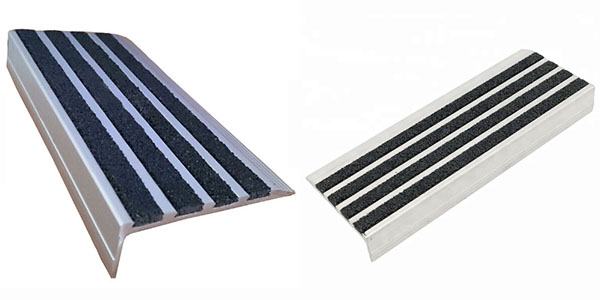There is nothing like the threat from a disgruntled stair nosing supplier to sue me if I do not retract my comments about purposely supplying non-compliant nosing. My answer to the retraction was simply ‘No” I had nothing to retract.
The reason for the threat is the compliance of the following style of commonly used stair nosings.

Striped style non-compliant stair nosings from a Chinese manufacturer as found on Alibaba.
Whilst the company name will remain redacted I thought it was a good time to discuss this type of nosings in question and why that style does not meet the prescriptive requirements of AS 1428.1:2009.
AS1428.1:2009 Figures 27(A) & (B)
The keywords within the above extracts are ‘Strip’ and ‘Colour’ both of which are used in a singular context.
This means the contrasting strip must be a ‘single strip’ and of ‘one colour’ only. The multiple strips nosings that are made up of bands of aluminium and coloured inserts, as shown above, do not meet this prescriptive requirement and are so non-compliant.
As detailed below, the maximum a stair nosing front face (any area of luminance contrast) is permitted to extend down the face of a riser is 10mm.
Standard stair nosing with a 50mm strip and maximum 10mm front extension on a square corner.
Any individual who specifies, supplies, certifies or installs such a product to a building that is required to be accessible (BCA Table D3.1) will be in breach of and potentially exposed to litigation as detailed in part 2.2 of the Disability (Access to Premises — Buildings) Standards 2010.
This is highlighted with the legal case of Toomey v Scolaro’s Concrete Constructions where a stair balustrade was found to be non-compliant and found to have contributed to a fall. In the end, Justice Geoffrey Eames decided that the responsibility of this case rests on a total of nine defendants and awarded $2.248M in damages paid by:
Balance 50% equally paid by the following:
Join the discussion on LinkedIn
Now we know what is required let’s go back to the very beginning and look at some of the key vision conditions that the nosing’s assist with. Information about these conditions is following along with images from two different stairs, the first with a solid yellow band and the second with a series of black strips. We have then applied vision conditions to them by using a vision impairment simulator to demonstrate their effectiveness.
The vision conditions applied from left to right are ‘Mild’, ‘Moderate’ & ‘Severe’ Note percentage population figures are from the UK.
Macular degeneration affects the part of the eye responsible for sharp, detailed central vision. It can cause blurring or darkness in the centre of the visual field, and can also affect the ability to see fine detail. It is particularly common in older people.
NOTE: In practice, the eye naturally focuses on the centre of its vision. This makes it very difficult to look at things outside of the grey area.
3.7% Population

Diabetic retinopathy is caused by complications of diabetes. Its effects vary and include blurred and patchy vision and floating spots in the visual field. Vision may also get better or worse during the day. If not properly managed, it can lead to blindness.
0.16% Population
Glaucoma is a group of eye conditions in which the nerve at the back of the eye is damaged. It is usually gradual and progressive, and is often not detected in early stages. Once detected, further damage can often be minimised. Glaucoma causes progressive deterioration of peripheral vision.
0.74% Population
Retinitis pigmentosa is a group of inherited disorders leading to gradual but progressive vision loss. The most common first symptom is difficulty seeing in poor light, which is usually followed by a loss of peripheral vision.
0.04% Population
A cataract is a clouding of the lens inside the eye, producing blurred vision and sensitivity to light. In addition, colours often seem faded, with a yellow or brownish tint. Most cataracts are age-related and progressive, but they are often removed once they interfere with daily life.
In short-sightedness, the eye has difficulty focusing on distant objects, so they seem blurred. The degree of blurring depends on the object’s distance, and close objects can still be seen clearly. In contrast, long sightedness makes close-up objects seem blurred, while distant ones are clear. Both are usually corrected with glasses or contact lenses but people may not wear these all the time.
Long-sightedness makes close-up objects seem blurred, while distant ones are clear. In contrast, in short-sightedness, the eye has difficulty focusing on distant objects, so they seem blurred. The degree of blurring depends on the object’s distance, and close objects can still be seen clearly. Both are usually corrected with glasses or contact lenses but people may not wear these all the time.
People with colour blindness cannot distinguish certain colours and therefore perceive a reduced colour set. This simulation shows the most common form, red/green colour blindness, which causes difficulties differentiating between reds and greens. Blue/yellow colour blindness also exists but is rare
Standard stair nosing with a 50mm strip and maximum 10mm front extension on a square corner.
Stair nosing with 50mm strip, luminescent strip and maximum 10mm front extension.
Insert stair nosing with maximum 15mm front offset
Carpet tile stair nosing with a 50mm strip and maximum 10mm front extension with square corner.
Carpet tile stair nosing with a 50mm strip and maximum 10mm front extension with rounded corner.
Stair nosing with a 25mm front extension. The maximum permitted 10mm. Could be considered with a performance solution
Standard stair nosing with a 50mm strip and maximum 10mm front extension on a rounded corner.
Stair nosing on a radiused tread corner: Type 1
Stair nosing on a radiused tread corner: Type 2
NOTE: All images are copyright Equal Access Group Pty Ltd 2018